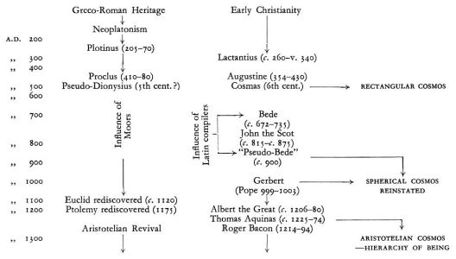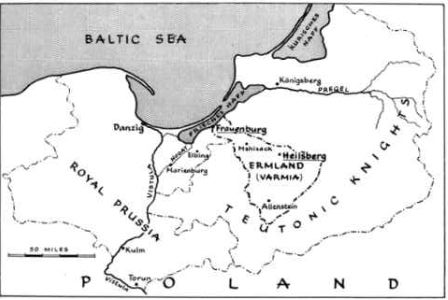The Sleepwalkers (51 page)
Authors: Arthur Koestler

However,
the
first
of
the
pioneers
of
the
new
era
did
not
belong
to
it,
but
to
the
old
one.
Though
born
into
the
Renaissance,
he
was
a
man
of
the
Middle
Ages:
haunted
by
its
anxieties,
ridden
with
its
complexes,
a
timid,
conservative
cleric,
who
started
the
revolution
against
his
will.
CHRONOLOGICAL
TABLE
TO
PART
TWO


PART
THREE
THE
TIMID
CANON
I
THE
LIFE
OF
COPERNICUS
1.
The Mystifier
ON
24
May,
1543,
Canon
Nicolas
Koppernighk,
1
by
his
Latin
name
Copernicus,
was
dying
of
a
haemorrhage
of
the
brain.
He
had
reached
the
age
of
three
score
years
and
ten,
and
had
published
only
one
scientific
work,
which
he
knew
to
be
unsound:
On
the
Revolutions
of
the
Heavenly
Spheres
2
.
He
had
delayed
publishing
his
theory
for
some
thirty
years;
the
first
completed
copy
of
it
arrived
from
the
printers
a
few
hours
before
his
death.
It
was
placed
on
his
bed,
so
that
he
could
handle
it.
But
by
then
the
Canon's
mind
was
wandering,
and
he
could
not
comment
on
the
anonymous
preface
to
the
book,
which
told
the
reader
that
its
contents
need
not
be
regarded
as
true,
or
even
as
probable.
Thus
posterity
never
knew
for
certain
whether
Canon
Koppernigk
had
authorized
that
preface,
and
whether
he
really
believed
in
his
system
or
not.
The
room
where
the
Canon
was
dying
was
in
the
north-west
tower
of
the
fortified
wall
surrounding
the
Cathedral
hill
of
Frauenburg
in
East
Prussia,
on
the
outskirts
of
civilized
Christendom.
He
had
lived
in
that
tower
for
thirty
years.
It
was
three
storeys
high:
from
the
second
floor
a
small
door
led
out
onto
a
platform
on
top
of
the
wall.
It
was
a
grim
and
forbidding
place,
but
it
gave
Canon
Nicolas
an
open
view
over
the
Baltic
Sea
to
the
north
and
west,
the
fertile
plain
to
the
south,
and
of
the
stars
at
night.

Between
the
town
and
the
sea
stretched
a
fresh-water
lagoon,
three
or
four
miles
wide
and
some
fifty
miles
long
–
a
famous
landmark
of
the
Baltic
coast,
known
as
the
Frisches
Haff
.
But
in
the
Book
of
the
Revolutions
the
Canon
insisted
on
calling
it
the
Vistula.
In
one
of
his
asides,
he
remarked
enviously
that
the
astronomers
of
Alexandria"were
favoured
by
a
serene
sky,
for
the
Nile,
according
to
their
reports,
does
not
exhale
such
vapours
as
the
Vistula
does
hereabouts."
3
Now,
the
Vistula
falls
into
the
sea
at
Danzig,
forty-two
miles
to
the
west
of
Frauenburg;
and
the
Canon,
who
had
lived
in
these
parts
nearly
all
his
life,
knew
perfectly
well
that
the
vast
expanse
of
water
under
his
tower
was
not
the
Vistula
but
the
Frisches
Haff
,
which
in
German
means
"fresh
lake".
It
was
a
curious
mistake
to
be
made
by
a
man
dedicated
to
scientific
precision
–
and
who,
incidentally,
had
been
commissioned
to
make
a
geographical
map
of
the
region.
The
same
mistake
is
repeated
in
another
passage
of
the
Book
of
the
Revolutions
:
in
the
chapter
"On
the
Longitudinal
Places
and
Anomalies
of
the
Moon"
it
is
said
that
"all
the
foregoing
observations
refer
to
the
meridian
of
Cracow,
since
most
of
these
were
made
from
Frauenburg,
on
the
estuary
of
the
Vistula,
which
lies
on
the
same
meridian."
4
But
Frauenburg
lies
neither
on
the
estuary
of
the
Vistula,
nor
on
the
meridian
of
Cracow.